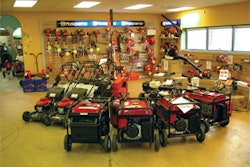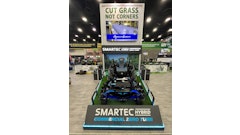
Today's dealers are more frequently making the decision to carry fewer product lines, focusing on those that provide better earnings. Deciding to drop a less-successful line can be difficult, and actually doing so can be strenuous. A line should only be dropped after thorough deliberation and extensive planning, in order to ensure a smooth execution.
Dealers today typically carry anywhere from four to nine product lines. This is a statistic that often depends on how long an individual has been in business.
After opening, many dealers continuously bring on new lines. Once they have built up a sizeable offering, they may decide to cut one of the underperforming lines. Whatever the deciding factor, whether it be overhead costs, weakened sales or diminished profits, a dealer's decision to drop a line is seldom an easy one.
BLINDING TIES
Many owners of outdoor power equipment dealerships are operating a business that was pioneered by their families many years ago. They grew up walking the showroom floor and have assumed the responsibility to maintain the family business. However, it is the deep-rooted connection to the product lines that can regularly get in the way of businesses succeeding to their full potential.
"Many times dealers hold on to lines that don't have enough demand in the customer base to really contribute to the inventory, training and floor space to make them work, just because of their history," explains George Keene, a member of Currie Management Consultants. "It's because the dealer is emotionally attached to the inventory. It's not a logical decision, it's an emotional attachment."
Connections are often built by dealers beyond their connection with the product line. If a dealer has been carrying a line for as long as they have been in business, friendships with the distributors often develop. A sense of guilt when considering whether or not to give up a line is understandable, but not necessary. While a dealer and distributor may share a friendly rapport, in talking business it should remain professional.
"Dealers need to be honest when dropping a product line," says Keene. "They should explain to the distributor that they have analyzed the line and decided it's not profitable enough to continue to carry. But they should also mention that they appreciate all the years of business had together."
Even further, some dealers have an attachment not only to the line or distributor, but to their loyal customers. If a customer has been choosing the dealership over the competition, returning again and again for service and parts on the same product line, dealers may struggle to drop that line. While the support of that customer can mean a lot to the business, it will not justify carrying a line that isn't performing as well as the others.
REMOVING THE BLINDFOLD
Many dealers do not fully understand the damage that an unsuccessful line can do to their bottom line. An extensive evaluation of the line is required to realize its downfalls. Once the actual harm of an unproductive line is realized, the decision to drop it is made much easier, even when considering the relationships involved.
In evaluating a line's value, a dealer should carefully consider every aspect of maintaining that line. Many facets often get by without deliberation. "In cutting lines, there are a number of things that dealers need to consider," Keene says. "They should look at the time and resources required for each aspect. There is so much additional overhead that goes with it that we don't take into account right away."
Dealers should carefully calculate the costs of maintaining a line including inventory, floor space, processing, technician training, insurance and taxes.
Keene advises that dealers weigh the lines against each other in each of these areas and as a whole. While dealers likely know which one of their lines is functioning at its best, they might not be able to pinpoint which is performing the worst. This exercise can shed valuable light on which lines are truly profitable and worth the dealership's efforts. "When doing the inventory and profitability analysis, we rank them from largest to smallest in sales volume, then we look at profitability, inventory investment, both equipment inventory and replacement parts inventory," says Keene.
The line or lines that fall far behind in the rankings are those that dealers should reconsider carrying. The profit the product is bringing in is not worth the effort the dealer is putting out.
SEEING IT THROUGH
Once the difficult decision to cut a product line has been made, the dealer must execute it in a timely manner. The most important thing for the dealer to remember is to remain courteous throughout the process. "There is nothing to be gained by burning bridges," Jim Miller, president of Four All Seasons Equipment in Harrisburg, PA, says. "You never know when the market will change, or who is going to buy who. Maintaining a working relationship is the only way to get a benefit out of it."
If after careful consideration a dealer decides to cut a line, they should contact their rep to discontinue the line. This is when being courteous helps the most. "Remaining courteous is in the best interest of the dealer," says Mike Elliott, TOP Equipment distributor in Texas. "If a dealer is really nasty about it, or drops our line because a competitor offered him incentive to do so, obviously there is a lot of leeway that a distributor can or cannot give. Like anything else in life, if you are treated right, you tend to be a little more easygoing and cooperative."
Maintaining that working relationship with the distributor can be helpful when dealing with the issue of eliminating inventory, parts, signage and displays form a dropped line. The depth of this issue does depend on the state lines within which the business is ran. In some states, when a line is dropped from a dealership, the distributor must take back all leftover inventory. This is true regardless of whether the decision to discontinue the line was made by the dealer or distributor.
"It is a state law, but there are restrictions," explains Elliott. "Equipment has to be current and boxed up. If it's an old unit, we don't have to do anything. But whatever is on the current price list has to be taken back, whether they drop our line or we decide to terminate them."
Beyond that, it is at the distributor's discretion how far they want to go when helping a dealer drop a line. Signage, literature and last year's equipment are all left for the dealer to dispose of. Elliott himself chooses to help the more courteous dealers locate others in their area that would be interested in picking up the remaining items.
If a dealer is less than courteous or is working with a distributor that will only assist as far as the law requires, they will have to take matters into their own hands. While most of the items will likely get junked, there are ways to get a little return on the investment.
"Anything that would be obsolete or superseded parts, as well as signage or literature, is yours and in most cases it is scrapped," says Miller. "One way we used to get rid of it is through an annual public auction. A lot of the vendor signs would sell, but the literature changes so fast that you just get rid of it." Another possibility for pushing pieces of a dropped line out the door is by selling them on sites like ebay.com or craigslist.org.
Once the equipment is eliminated, dealers are faced with the issue of maintaining previously sold products. According to Elliott, this is something dealers often forget to consider, which can put them in a difficult situation when a customer returns for service. Some distributors will allow a dealer to carry parts throughout the warranty period, while others will refuse them altogether. Before dropping a line, dealers should work with distributors to carefully develop a plan for how to handle equipment already sold.
A NEW LINE, A NEW TIE
One of the many reasons a dealer decides to drop a line may be to add another that they feel has more to offer themselves and their customers. Before adding a new line, dealers should be sure to evaluate it meticulously to prevent another situation where they are carrying an unsuccessful line. A great resource to consult when considering a new line is other dealers in the area that carry it. Carl Levien, of Carl's Mower & Saw in Ferndale, WA, did just that when he dropped two unprofitable lines to add another that promised more success. "I did my homework because I didn't want to make quick or reactionary decisions," says Levien. "I talked to dealers that I have a good relationship with about the line before adding it."
Another way to evaluate the line is by asking trusted customers for their input. "Before we even bring on a line, we like to put it into the customers' hands," says Miller. "We will ask our distributors for demos we can put out in the field and get some feedback on." Miller explained that for a commercial line they offer it to their top 10 customers for a trial run and then ask for their feedback on the equipment's performance.
Once the customer-approved line is added, it should be aggressively marketed. Bringing on a line during the appropriate season and extensively marketing from the start is essential to its success. In developing a marketing campaign, the distributor may be a great resource. Elliott helps his dealers greatly with a tailor-made marketing campaign.
"If I know a dealer is going to sell my line and they've dropped somebody else's, I provide them with as much competitive comparison information as possible," Elliott says. "I want them to feel very comfortable selling my product against whatever they compete with." In addition to selling the product line through literature, equipment should be placed in the front of the showroom or just outside the doors so that it is introduced to the customer as soon as they approach.
Introducing a new line to the returning customer doesn't have to be difficult. If the dealer shows confidence in the new line and thoroughly explains its benefits, customers should be put at ease. Many loyal customers will trust that the decision the dealer has made about a line is the right one.
"Selling customers on a new line comes down to the trust and relationships we have built with them," explains Levien. "Our customers trust us to sell them what is best for their needs. It is best to be honest and explain the reasoning without being negative."
Still, some customers may not be convinced. If they are unhappy that they were sold a line that was eventually dropped, dealers should approach each situation differently. A rebate or discount with the return of old equipment when purchasing from a new line may be appropriate in some cases.
"If we are talking about a lawn mower or tractor, it is a different story from a lower-end string trimmer," Keene says. "If it is something small like a string trimmer, I suggest dealers give the customer full credit and exchange it for the new product. If it's a lawn mower with a ticket price of two or three thousand dollars, make some company judgment."
It is to the advantage of the business, and the customer, that dealers are more commonly deciding to carry fewer product lines. "We provide a product that will best meet our customers' needs in the long run," says Levien. "They want us to be here 10 years from now, continuing to service their equipment." By concentrating on the lines that provide larger revenue and profit, dealerships will house a focused and profitable offering, where they are able to give customers high-quality service.
The decision to drop a less-successful line can be complicated, and the process of doing so strenuous. Dealers should remain courteous and respectful when working with their reps to carefully develop a plan of action for eliminating the line. Customer relationships should also be maintained to secure the continued success of the business's remaining lines— and the dealership as a whole.



















